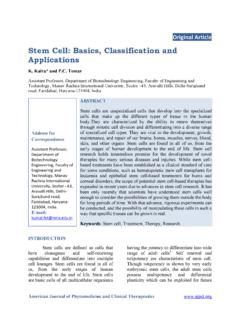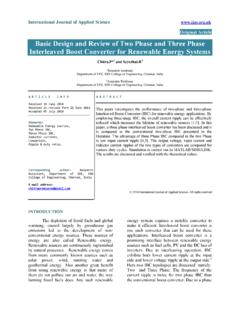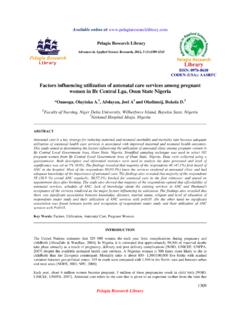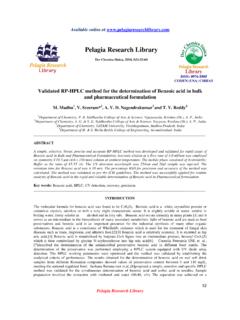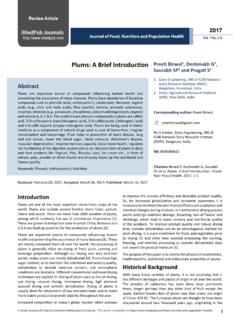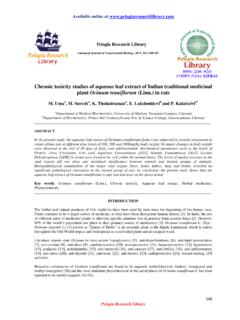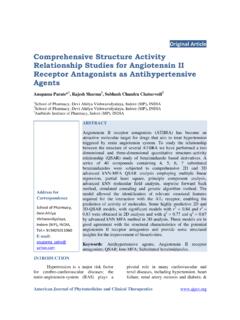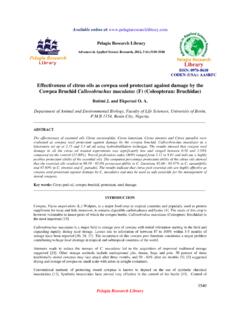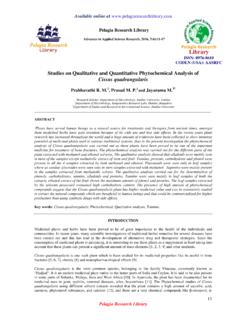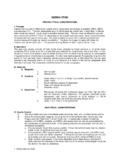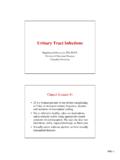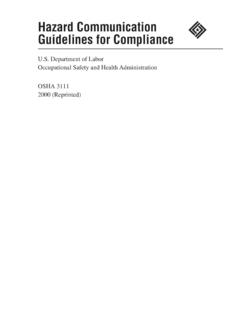Transcription of Formulation and Evaluation of Fast Dissolving Oral …
1 American Journal of Advanced Drug Delivery American Journal of Advanced Drug Delivery Original Article Formulation and Evaluation of fast Dissolving Oral Films of Zolmitriptan A. Deepthi*, B. Venkateswara Reddy, and K. Navaneetha Department of pharmaceutics, St. Pauls College of Pharmacy, Turkayamjal (V), Hayathnagar (M), Ranga Reddy Dist-501510, India. ABSTRACT The present study was aimed to formulate and evaluate fast Dissolving oral films of Zolmitriptan using sodium alginate, xanthan gum and sodium starch glycolate, guar gum.
2 The suitable plasticizer and its concentration were selected on the basis of flexibility, tensile strength and stickiness of the film. The films are prepared by solvent casting method and characterized by UV, FTIR studies. The films were evaluated for disintegration time, Folding endurance, Tensile Strength, Mouth Dissolving time, Thickness, content uniformity and In-vitro dissolution studies. The F5 Formulation has given drug release within 6 minutes and has a tensile strength of MPa. Keywords: Zolmitriptan, Sodium alginate, Aloevera and Solvent casting.
3 INTRODUCTION fast Dissolving oral films (FDOFs) or Oral wafers or Oral strips (OS) or sublingual strips or oral thin films (OTF) are the most advanced form of oral solid dosage form due to more flexibility and comfort1. It improves the efficacy of APIs by Dissolving within minute in oral cavity after the contact with saliva without chewing and no need of water for administration. It gives quick absorption and instant bioavailability of drugs due to high blood flow and permeability of oral mucosa is 4-1000 times greater than that of skin2,3.
4 FDOFs are useful in patients such as pediatric, geriatrics, bedridden, emetic patients, diarrhea, sudden episode of allergic attacks, or coughing for those who have an active life style4,5. It is also useful whether local action desired such as local anesthetic for toothaches, oral ulcers, cold sores or teething. At present Zolmitriptan is available in the form of tablets, nasal sprays in the market. Patients Date of Receipt- 03/02/2014 Date of Revision- 10/02/2014 Date of Acceptance- 25/02/2014 Address for Correspondence Department of pharmaceutics, St.
5 Pauls College of Pharmacy, Turkayamjal (V), Hayathnagar (M), Ranga Reddy Dist-501510, India. Tel. +91-9550657064. E-mail: A. Deepthi et al_____ ISSN 2321-547X AJADD[2][2][2014]153-163 are non co-operative with these dosage forms6. Hence oral disintegrating films have become important tool to improve the patient compliance. MATERIALS AND METHODS Chemicals Zolmitriptan was obtained from Chandra labs, Hyderabad, India. Remaining other chemicals like Guar gum, Xanthan gum, Alovera, Sodium alginate, Poly ethylene glycol 400, Sodium starch glycolate, Vanillin, Sodium Saccharine were obtained from Research-lab fine Chem industries Mumbai.
6 Preparation of fast Dissolving oral films7,8 Film was prepared by using specified polymer by solvent casting method. The specified amount of polymer was weighed and dissolved in specified amount of water for overnight to get a uniform dispersion of different % (w/v) solutions. Drug, sodium starch glycolate, vanillin were dissolved in specific amount of water in a beaker. The drug solution was added to the polymer solution and mixed using magnetic stirrer for 1 hour. The resulting solution was degassed so as to remove any bubbles formed.
7 The bubble free solution was casted on to a Petri dish of surface area cm2. It was dried for 24 hours at room temperature. The film was removed from the Petri dish very carefully and observed for any imperfections. Film that was clear and bubble free was selected for further studies. Film of area cm2 ( X ) was cut and stored in a butter paper covered with aluminum foil and stored in desiccators. Composition of various formulations is shown in table-1 and the images of the films are given in the figures 1, 2, 3 and 4.
8 Drug polymer compatibility studies Study was carried out using FT-IR spectrometer. FT-IR Spectra of Zolmitriptan and polymers with Zolmitriptan were obtained. The spectrum was studied for specific peaks of drug and polymer. The spectra are shown in figure 5-9. Physical characterization of fast Dissolving oral films9,10 A. Weight variation of the film cm2 films were cut at five different places in the caste film. The weight of each filmstrip was taken and the weight variation was calculated. B. Thickness of the film The thickness of the patch was measured using digital Vernier Calipers with a least count of mm at different spots of the film.
9 The thickness was measured at three different spots of the patch and average was taken and SD was calculated. C. Tensile strength Tensile testing was conducted using a texture analyzer AG/MC1 (Acquati, Italy), equipped with a 5 N load cell. The film was cut into 30 20 mm strips. Tensile tests were performed according to ASTM International Test Method for Thin Plastic Sheeting (D 882-02). Each test strip was placed in tensile grips on the texture analyzer. Initial grip separation was 20 mm and crosshead speed was 1 inch/min.
10 The test was considered concluded when the film breaks. Tensile strength, was computed with help of load require to break the film and cross sectional area to evaluate tensile properties of the films. Tensile strength (TS) Tensile strength is the maximum stress applied to a point at which the film specimen breaks and can be calculated by dividing the maximum load by the original cross-sectional area of the specimen and it was expressed in force per unit area (MPa). Tensile Strength = Force at break (N)/ Cross sectional area (mm2) A.

